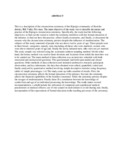| dc.description.abstract | This is a description of the circumcision ceremony of the Kipsigis community of Kericho district, Rift Valley Province. The main objective of the study was to describe
the nature and practice of the Kipsigis circumcision ceremony.
Specifically, the study had the following objectives: to find out the extent to which the ceremony interferes with the formal education of the initiates, to find out how this practice. affects family economies, and finally, to document the reasons why the circumcision ceremony persists despite the influence of modernization.
The subjects of this study consisted of people who are
above twelve years of age. These people were in three broad
,
categories, namely, men (including all those who were married),
women who were above nineteen years of age and, finally the newly initiated men, who were not yet married.
The study sample was selected using the systematic random sampling method. On the other hand, the lottery method was used to thee divisions and locations from which the interview
was to be carried out. The main method of data collection was an interview schedule with both structured and unstructured questions. The questionnaire had both open-ended and closed questions. Other methods of data collection used included unobstrusive research, participant observation, and key informants. the data thus obtained were edited, quantified, coded and finally analysed by quantitative method involving simple descriptive statistics using frequency tables of simple percentages.
The study came up with a number of results. First, the circumcision ceremony affects the formal education of the initiates. Second, the ceremony affects the financial capabilities of the families concerned. Third, the ceremony persists despite the ravages of modernization. Fourth, there IS a correlation between the knowledge
of symbolism and age of an individual possessing the knowledge.
The study makes several recommendations which include the utilization of competent and experienced medical practitioners or medical officers; use of one
scarpel on each initiate to avoid sharing and, finally, incorporation of the expectations of formal education in the teaching processes of the ceremony. | en |

